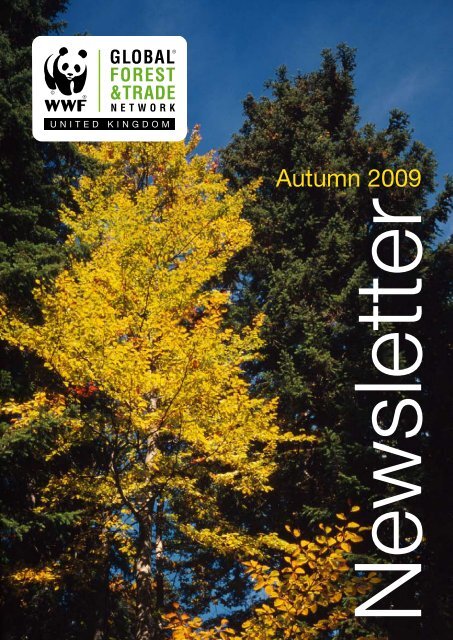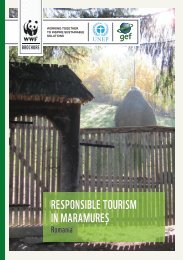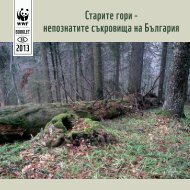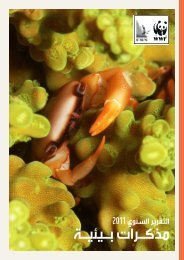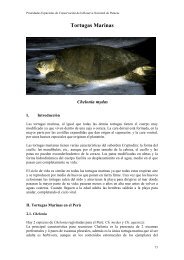Autumn 2009 - WWF
Autumn 2009 - WWF
Autumn 2009 - WWF
- No tags were found...
You also want an ePaper? Increase the reach of your titles
YUMPU automatically turns print PDFs into web optimized ePapers that Google loves.
6<strong>WWF</strong> GFTN NEWSWAFPO programme coordinator madeboard member in Ghana<strong>WWF</strong>-WAFPO’s programme coordinator, Dr. Kwame AsamoahAdam, has been made a member of the board of the ForestryCommission of Ghana. This position was offered to him in hiscapacity as the President of the Ghana Institute of Foresters.Dr Adam has been the programme coordinator for WAFPOsince September 2008. His presence on the board will provide<strong>WWF</strong> an opportunity to push forward conservation concernsin Ghana as well as West Africa as a whole. Prior to joining<strong>WWF</strong>, he held a senior research scientist position within theForestry Research Institute of Ghana.WAFPO is currently implementing the GFTN programme, a<strong>WWF</strong> initiative to eliminate illegal logging from supply chainsand transform the global marketplace into a force for savingthe world’s valuable and threatened forests.Unsustainable logging threatensgreat apesThe continued existence of all species of great ape dependson the conservation of the tropical rainforests. Recognisingthat the majority of great apes live outside of formallyprotected areas, where logging is the most common landuse, a new <strong>WWF</strong> report “Great apes and logging” comparesthe consequences of different types of logging for a varietyof species in general, and for great apes in particular. Thiscomparison was based on scientific studies and informationprovided by large timber companies and conservationsocieties.<strong>WWF</strong> GFTN-UK Newsletter <strong>Autumn</strong> <strong>2009</strong><strong>WWF</strong>-Indonesia and TBI committo save Kalimantan forestsFrom Bogor (Antara News): <strong>WWF</strong>-Indonesia and TheBorneo Initiative (TBI) have officially made a commitment tosave the forests in Kalimantan, considered among the mostvaluable in the world.<strong>WWF</strong>-GFTN Indonesia coordinator Aditya Bayunandaconfirmed that a memorandum of understanding (MoU) wassigned on 11 August <strong>2009</strong>.The memorandum formally marked an agreement to curbillegal logging and achieve sustainable forest management inKalimantan through credible forest certification. Both <strong>WWF</strong>-Indonesia and TBI believe that well preserved forests arepossible through sustainable management, high social andeconomic viability, and a high proportion of conservationareas.“The signing of the MoU signifies the close collaborationbetween GFTN and TBI to accelerate the certification ofsustainable forest management in Indonesia,” Bayunandasaid.“The involvement of all major stakeholders such asgovernment, the private sector, forest management units,communities and NGOs is the key to the success of thecontribution to the sustainable management of Kalimantan`sforests,” continued Bayunanda.Read more at: www.antara.co.id/en/news/1251198181/wwfindonesia-tbi-commit-to-save-kalimantan-forestsIn the Congo Basin only 10-15% of the forests in the areasinhabited by the chimpanzee, bonobo and gorilla are legallyprotected as national parks or nature reserves. In Indonesiaand Malaysia, where the orang-utan live, only 20% of theforests are legally protected. In some countries up to 90% ofthe area is leased as a logging concession.Download the report at: www.gftn.panda.org/?174101/Unsustainable-Logging-Threatens-Great-Ape-Populations8
<strong>WWF</strong> GFTN-UK Newsletter <strong>Autumn</strong> <strong>2009</strong>there’s a way in which we can provide a solution, and we havecome up with various proposals,” he continued.“But, if by the time we reach Copenhagen in Decemberthere’s a means by which we can introduce an emergencypackage to halt deforestation, or bring it under control, notonly would it actually buy us time in the battle against climatechange because of the services provided by those rainforests,but it would also help very substantially to make a differenceto the lives of many of the poorest people on this Earth.”Read more at:http://news.bbc.co.uk/1/hi/7400911.stmOfficial report confirms rape by loggersFrom Bruno Manser Fund: The Malaysian government hasconfirmed that logging company workers sexually abusedwomen and girls in the east Malaysian state of Sarawak. Therecognition comes a year after the Bruno Manser Fund starteda campaign to highlight the abuse.According to the independent Malaysian news service,Malaysiakini, a previously confidential report by the MalaysianMinistry for Women, Family and Community Development listsat least eight cases of sexual abuse of Penan girls and womenby logging company workers. The report states that several ofthe victims were schoolgirls as young as 10.The report concludes that “allegations of sexual abuse ofPenan girls and women by outsiders dealing with the Penan,including logging company workers and merchants, didindeed take place.” It quotes two rape victims as saying thatit is a regular and common occurrence for logging campworkers to sexually abuse girls who hitch rides to and fromschool.The logging companies involved originally denied theallegations.Read more at: www.bmf.ch/en/news/?show=168FSC invites views on plantationsFrom FSC.org: A team of experts focused on the issue ofconversion in the FSC Plantations Review has released a finalreport for consultation. FSC invited all interested stakeholdersto comment on the report before 30 September <strong>2009</strong>.The final report, “Review of FSC conversion policy” providesan in-depth analysis of the conversion issue and proposes anew approach towards conversion in the FSC system. A newcriterion would replace criterion 6.10 and criterion 10.9 of thecurrent version in the FSC Principles and Criteria (FSC-STD-01-001V4-0).The report offers an important contribution to support thecurrent review of the Principles and Criteria. Stakeholdercomments on the report will be directed to the P&C WorkingGroup who will then propose specific changes related toconversion in the next draft of the P&C.Read more at: www.fsc.org/newsroom.htmlVictory for Greenpeace andreindeer in LaplandFrom Greenpeace International: After seven years ofGreenpeace pressure, government-owned logging companyMetsähallitus has agreed to leave the tall trees of northernLapland standing, and with them the livelihood of the Sámipeople.The company and local herders signed a logging moratoriumfor 20 years, protecting some of the last old-growth forestsleft in Europe and ending a long-standing conflict between theherders and Finland’s state forest service.Read more at: http://www.greenpeace.org/international/news/victory-for-greenpeace-and-reiSpears versus bulldozers in BorneoFrom Aljazeera.net: In the jungles of central Borneo, loggersand native tribes, environmentalists and plantation companies,rights lawyers and government developers are now locked inan increasingly desperate battle.The future of one of the world’s last great rainforests is atstake and the results of this fight could determine muchbeyond Borneo’s borders too. Environmental scientists have15
<strong>WWF</strong> GFTN-UK Newsletter <strong>Autumn</strong> <strong>2009</strong>become increasingly alarmed at the effect deforestation takingplace in the area is having on the world’s weather.The current front line in this confrontation lies about 160kminland from the town of Miri, in the eastern Malaysian state ofSarawak, on the island of Borneo.In recent days a string of barricades have gone up by theUpper Baram river, as native tribes try to prevent logging andplantation companies entering what the tribesmen see as thelast remnants of their land.Read more at: http://english.aljazeera.net/focus/<strong>2009</strong>/08/<strong>2009</strong>829113154312206.htmlVietnam outsources deforestation toneighbouring countriesFrom Mongabay.com: By conserving forests whileexpanding its export-oriented wood products industry,Vietnam outsources deforestation to Laos, Cambodia andChina, according to a new study.Like China, Vietnam has experienced a resurgence in forestcover over the past twenty years. This is largely a resultof forestry policies that restricted timber harvesting andencouraged the development of processing industries toturn raw log imports into finished products for export. Thesemeasures contributed to a 55% increase of Vietnam’s forestcover between 1992 and 2005, while bolstering the country’sstunning economic growth.Read more at: http://news.mongabay.com/<strong>2009</strong>/0902-vietnam.htmlRussia may delay export dutiesFrom TTJ online: Higher export duties on Russianroundwood could be postponed until 2011, according tomedia reports from the country.A decision on the timing of the next round of Russian dutyincreases is likely to be taken in the autumn. The duty rises,designed to boost further processing of timber within Russia,have already been delayed during 2010.Meanwhile, a timber summit between the Russian and Finnishprime ministers may be on the cards in October, with thepossible participation of major wood processors.UK chief construction adviser could be in place by NovemberFrom Building.co.uk: A chief adviser on construction could bein place by November in the UK, ministers have announced.The official would chair a board overseeing value for money inprocurement and promote innovation and sustainability.Read more at: http://www.ttjonline.com/story.asp?sectioncode=17&storycode=60249Chirac calls for greater support for FSCFrom FSC.org: The construction industry can play afundamental role in promoting the use of FSC-certified timber,according to speakers at a Foundation Chirac and TFT eventheld at the French Quai Branley Museum in Paris.The necessity to change attitudes towards more responsiblewood purchasing was a key message that resonated at thepartnership event.Jacques Chirac highlighted the role the construction industryshould play in the fight against deforestation and illegal trade.Outlining the same ideals that led to the establishment ofFSC in 1993, the former French president recommendedcollaboration between forest companies, the constructionsector, businesses and forest-dependant people.He also drew attention to the need for cultural diversity; rightsfor all to land and food safety; the importance of caring forfuture generations and making sure local populations aregiven a say in the fate of their forest.16
<strong>WWF</strong> GFTN-UK Newsletter <strong>Autumn</strong> <strong>2009</strong>Among the key speakers was Robert Hunink, CEO of thefirst FSC-certified company in the Congo Basin, CongolaiseIndustrielle de Bois (CIB). Mr. Hunink explained the companyneeded a market ready to pay a price premium for FSC-certifiedwood. He called for governmental support on all levels, fromthe EU to local and regional councils, to take measures toencourage FSC purchases, such as public procurementpolicies or tax rebates.Read more at: www.fsc.org/newsroom.htmlColombia commits to stopping illegaltimber tradeA new pact for legal timber in Colombia will enhance forestmanagement and conservation in the country, home to 29%of the world’s forests.In a joint effort led by the Colombian Ministry of Environment,the Regional Environmental Authority of the Province ofRisaralda (CARDER), the National Timber Industry Federation(Fedemaderas) and <strong>WWF</strong>-Colombia, twenty four organisationsmade an unprecedented commitment to put an end to theillegal timber trade. They also pledged to implement a nationalpolicy to promote legal timber and improve forest governancein Colombia.Colombia has retained approximately 50% (55m ha) of itsoriginal forest cover, 50% of which is within ethnic territories,primarily in the Chocó-Darién Ecoregion and the AmazonBasin. Illegal timber exploitation and trade generates negativeenvironmental and socioeconomic impacts. It affects boththe performance of the sector, and its contribution to nationalGDP, as well as security, well-being and livelihoods of localcommunities.Read more at: www.gftn.panda.org/newsroom/?172901/Colombia-commits-to-stop-illegal-timber-tradeAustralia goes soft on timber banFrom theage.com: Australian forestry minister TonyBurke has quietly watered down an election promise to‘’ban’’ imports of timber illegally logged overseas to instead‘’promote the trade’’ of legal timber.It comes as the peak body for the local plantation and paperindustry joins Greenpeace to call for the government to fulfillan election promise to block illegal timber imports.In a document obtained by The Age and signed by Mr Burkein January, the Department of Agriculture, Fisheries andForestry recommends the new policy direction be adopted asit ‘’leaves open the option to consider a broad range of policyoptions for combating illegal logging’’.The document also says the domestic industry has concernsthat ‘’any action’’ to block timber from illegal logging overseasmay hurt its bottom line.Read more at: http://www.theage.com.au/national/australiagoes-soft-on-timber-ban-<strong>2009</strong>0824-ewjf.htmlFinnish sawn timber down 30%From illegallogging.info: Finnish sawn timber productionwas down about 30% in the first half of <strong>2009</strong> compared to ayear ago, according to a new report.The Finnish Forest Industries Federation’s latest ForestIndustry Review also says production for the period totalled3.8m sq m.Second quarter production was 1.9m sq m, 35% less than ayear ago, while sawn timber prices were around a fifth lowerthan 2008.Plywood production slipped 49% in the first half to 370,000sqm, while second quarter output was 45% down at 200,000sqm.The value of the wood product industry’s production in thesecond quarter was almost halved from last year to just under€900m.17
<strong>WWF</strong> GFTN-UK Newsletter <strong>Autumn</strong> <strong>2009</strong>A community-based approach tosustainable managementIn the last week of July representatives from <strong>WWF</strong> offices metwith key partner organisations and Community Based ForestEnterprises (CBFEs) at the International Meeting on CBFEs,held in Bolivia.Every country represented at the meeting, from Panamato Papua New Guinea and Cameroon, has tropical foreststhat need to be protected. They also have large groups ofindigenous rural communities that depend on forests as theirsource of income, food, medicine and construction materialfor their homes and other buildings. These countries also haveenvironmental policies that, in general, favour the developmentof CBFEs.The organisers gathered opinion to develop future strategiesto continue supporting CBFEs in these regions. A seriesof technical articles will be produced summarising lessonslearned about policies; legislation and regulation; organisation;management and and social effects; production systems;responsible forest management; markets and funding ofCBFEs.Read more at: http://gftn.panda.org/newsroom/?171741/Community-Based-Forest-Enterprises-in-Latin-America-Africa-and-Asia-sustainably-manage-the-forestRussia to discuss illegal timber exportswith Finland and ChinaFrom Illegal logging.info: President Dmitry Medvedevrecently said he would discuss illegal timber exports fromRussia at talks with Finnish and Chinese leaders, reportsITAR-TASS.“The situation is outrageous,” Medvedev said at a meetingwith the leaders of parliamentary parties in the city of Sochi.Finland and China are major importers of Russian timber.Some exporters have started smuggling timber abroad sinceRussia began gradually hiking the duty on unprocessed timberexports in 2007.Read more at: http://www.illegal-logging.info/item_single.php?it_id=3622&it=newsRussia specifies FSC timber forWinter OlympicsFrom TTJ online: FSC-certified timber has been specified foruse in the 2014 Winter Olympics in Russia.FSC-certified timber is recommended for use in allconstruction work, including new buildings, transport andenergy infrastructure. The games’ green specificationstandard says only wood with legal documentation and proofit does not come from conservation areas will be permitted tobe used.Read more at: http://www.ttjonline.com/story.asp?sectioncode=17&storycode=6000318
<strong>WWF</strong> GFTN-UK Newsletter <strong>Autumn</strong> <strong>2009</strong>New FSC good practice guide focuseson biodiversityFrom FSC.org: FSC has published a new guide intended tohelp managers and owners of small-scale and low intensityforest operations maintain or improve the management ofbiodiversity and high conservation values within their forests.It’s designed to help meet FSC certification requirementsfor biodiversity and conservation through the process ofidentification, management and monitoring. The guide is oneof several resources created under the FSC GEF project onimproved certification systems for sustainable tropical forestmanagement.Read more at: www.fsc.org/newsroom.htmlG8 get behind sustainable forestmanagementFrom TTJ online: Declarations made at the G8 included acommitment to combine the reduction of carbon emissionsfrom deforestation with the global promotion of sustainableforest management.The meeting, held in L’Aquila in Italy during July, also sawsupport for reducing emissions from the Deforestation andDegradation Initiative, which offers financial incentives fortropical countries to safeguard their forests.G8 leaders also focused on illegal logging, signalling theircommitment to improve cooperation in combating the trade inillegally-harvested wood.Read more at: http://www.ttjonline.com/story.asp?storyCode=60012§ioncode=1719
9GFTN GLOBAL UPDATES<strong>WWF</strong> GFTN-UK Newsletter <strong>Autumn</strong> <strong>2009</strong>North America• 8 companiesSouth America & Caribbean• 2.1 million Hectares• 32 companiesRussia• 20.9 million HectaresEurope• 47 companies• 157 companiesAfricaAsia• 3.0 million Hectares• 2.1 million Hectares• 12 companies • 86 companiesOceania• 8 companiesGlobal Totals300+ Companies2.30 million People employed34 Countries 250 million cubic metres RWE Traded27.3 million Ha managed $63 billion USD Sales in forest productsFSC certified forest area by continent (as of September <strong>2009</strong>):Europe: 53,240,908haNorth America: 39,152,283haSouth America and Caribbean: 11,695,904haAfrica: 7,095,531haAsia: 2,761,603haOceania: 1,659,330haTotal global FSC-certified area: 115,605,559haMaps and data on FSC – September <strong>2009</strong>:www.fsc.org/fileadmin/web-data/public/document_center/powerpoints_graphs/facts_figures/09-09-15_Global_FSC_certificates_-_type_and_distribution_-_FINAL.pdfFSC certified forests by country – September <strong>2009</strong>:www.fsc.org/fileadmin/web-data/public/document_center/powerpoints_graphs/facts_figures/09-09-15_Global_FSC_certificates_-_type_and_distribution_-_FINAL.pdfRegional totals: FSC Chain of Custody certificates –September <strong>2009</strong>:www.fsc.org/fileadmin/web-data/public/document_center/powerpoints_graphs/facts_figures/09-09-15_Global_FSC_certificates_-_type_and_distribution_-_FINAL.pdfRegional totals: FSC forest management certificates –September <strong>2009</strong>:www.fsc.org/fileadmin/web-data/public/document_center/powerpoints_graphs/facts_figures/09-09-15_Global_FSC_certificates_-_type_and_distribution_-_FINAL.pdfFor more information please visit: www.fsc.org21
10UPCOMING GFTN AND EXTERNAL EVENTS<strong>WWF</strong> GFTN-UK Newsletter <strong>Autumn</strong> <strong>2009</strong>For an updated list of GFTN events please visit: http://gftn.panda.org/newsroom/events/International Conference on Loggingand Industrial Ecology <strong>2009</strong>3-5 November <strong>2009</strong> - Nanjing Forestry University, Nanjing,China. The International Conference on Logging and IndustrialEcology <strong>2009</strong> (ICLIE’09) will be held in Nanjing, China.The purpose of the conference is to showcase the latestdevelopments in the field of logging and related technology inindustrial ecology. It will promote the developments of forestoperation in timber harvesting and transportation under theguidance of industrial ecology as well as the research in thefields above.For more information please visit: http://iclie09.njfu.edu.cn/Forest Day 313 December <strong>2009</strong> - Copenhagen, Denmark. This year is possiblythe most important year for forests in living memory. Weare in the final stretch of the road to Copenhagen, andCOP 15, where negotiators expect to finalise a post-Kyotoglobal climate agreement in December. To coincide with theconference, CIFOR, the Collaborative Partnership on Forests(CPF) and the Government of Denmark will host Forest Day 3.Forest Day 3 will build on the success of Forest Day 1 and 2in helping to ensure forests are high on the agenda for futureclimate outcomes, and will pave the way forward in makingthese outcomes work beyond Copenhagen.Chatham House-RRI Dialogue on Forests,Governance & Climate Change No 322 January 2010 – The third in the series of meetings aimingto promote learning and frank discussion on the key issuesfacing forests and forest communities as the world scales upefforts to mitigate and adapt to climate change. This meetingwill include a chance to discuss what was agreed (and whatwas not) at the Copenhagen climate change conference at theend of <strong>2009</strong>.For more information contact Alison Hoare: alhoare@chathamhouse.org.ukIllegal Logging Update and StakeholderConsultation No 1520-21 January 2010 - The fifteenth in the series of illegallogging update meetings organised by Chatham House.For more information contact Alison Hoare at: alhoare@chathamhouse.org.ukFor more information please visit: www.cifor.cgiar.org/Events/ForestDay3/Introduction/22
11USEFUL <strong>WWF</strong> DOCUMENTSAND REPORTS<strong>WWF</strong> GFTN-UK Newsletter <strong>Autumn</strong> <strong>2009</strong>Summary of the report by Martin WalterAnalysis of the FSC and PEFC Systems for Forest Certification using the FCAG 2008In collaboration with the World Bank, <strong>WWF</strong> developed the Forest Certification Assessment Guide 1(FCAG) in 2006, to assess the quality and credibility of forest certification schemes.In recognition of the dynamic nature of forest certification, in 2008 <strong>WWF</strong> commissioned an assessmentusing the FCAG of the two global certification systems: the FSC (Forest Stewardship Council) and PEFC(Program for Endorsement of Certification Systems) to help <strong>WWF</strong> review its position on crediblecertification. The assessment focused on the rules set by these systems internationally, supplemented byan assessment of a sample of national FSC and PEFC standards/schemes, i.e. in Germany, Australia andChile, to permit evaluation of elements that could not be assessed at international level.<strong>WWF</strong>-UKFOREST AND TRADE NETWORKANNUAL REVIEW <strong>2009</strong>The 2008 assessment showed few changes at the international level in either the FSC or the PEFC systemssince the last assessment in 2005.The table provides a visual summary of the assessment by presenting the percentage of fulfilled indicatorsper criteria for PEFC and FSC at international level as well as the national schemes. Where compliancewith a criterion involved assessment of the national schemes in Australia, Germany and Chile, thepercentage for the lowest-scoring national scheme is used in the table. The table shows that there are considerable differences between the FSC and PEFC at the systems level.This is partly due to the different100% Fulfilledapproaches used by the two systems – 100% Not fulfilledmore international control for FSC 70% or more fulfilledPEFC FSCversus more national autonomy for Less than 70% fulfilledPEFC.Criterion 1 — Compliance with internationalframeworks for certification, accreditation, and 80% 80%standard settingThe lowest score for the FSC, onCriterion 2—Compatible with globally applicableCriterion 3, stems from the use ofprinciples that balance economic, ecological, andequity dimensions of forest management and meet 68% 91%interim standards where no national Global Forest Alliance requirementsstandards are in place. Where FSCendorsednational standards exist,Criterion 3 — Meaningful and equitableparticipation of all major stakeholder groups in 22% 72%governance and standard settingnational FSC schemes score 100% for Criterion 4 — Avoidance of unnecessary obstacles no nothis criterion. Due to the central control to trade 2indicators indicatorsCriterion 5 — Based on objective and measurablestructures within FSC, other nationalperformance standards that are adapted to local 100% 100%FSC schemes are unlikely to score below conditionsCriterion 6 — Certification decisions free ofthe scores for FSC in the table.conflicts of interest from parties with vested no nointerests 2indicators indicatorsIn the case of PEFC, the higher level of Criterion 7 — Transparency in decision makingand public reporting 36% 100%national scheme autonomy results in Criterion 8 — Reliable and independentgreater variability between national assessment of forest management performance 47% 89%and chain of custodyschemes. Thus, other national PEFC Criterion 9 — Delivers continual improvement inschemes could score higher or lower forest management 50% 100%Criterion 10 — Accessible to and cost-effective forthan the scores for PEFC in the table.all parties 75% 100%Criterion 11 — Voluntary participation 25% 100%New - <strong>WWF</strong> GFTN-UK Annual Report 2008-09<strong>WWF</strong>, October <strong>2009</strong>This is the <strong>WWF</strong>-UK Forest & Trade Network’s fifth annualreport, which covers the management, activities andachievements of its members in 2008-09View this report at: wwf.org.uk/what_we_do/safeguarding_the_natural_world/forests/forest_trade_network/ftn_publications.cfm?3356/Forest--Trade-Network-Annual-Report-200891. The FCAG available at: http://assets.panda.org/downloads/fcagfinal.pdf2. Criteria 4 and 6 have no specific indicators as these topics are covered elsewhere in the FCAG, specifically in C1.Analysis For more info contact: Margareta Renstrom, of <strong>WWF</strong> International, the margareta.renstrom@wwf.se FSC and PEFC Systems for ForestCertification Using the FCAG 2008 – a summaryof the report, by Martin Walter<strong>WWF</strong>, February <strong>2009</strong>In collaboration with the World Bank, <strong>WWF</strong> developed theForest Certification Assessment Guide (FCAG) in 2006,to assess the quality and credibility of forest certificationschemes.In recognition of the dynamic nature of forest certification, in2008 <strong>WWF</strong> commissioned an assessment using the FCAG ofthe two global certification systems to help review its positionon credible certification. The assessment focused on the rulesset down by these systems internationally, supplementedby an assessment of a sample of national FSC and PEFCstandards and schemes – in Germany, Australia and Chile – topermit evaluation of elements that could not be assessed atinternational level.View the summary of this report at: http://assets.panda.org/downloads/<strong>2009</strong>_01_27_final_fcag_summary.pdf23
Keeping the Amazon forests standing: a matter of values<strong>WWF</strong> GFTN-UK Newsletter <strong>Autumn</strong> <strong>2009</strong>Keeping theAMAZO NFORESTSstanding: a matter of valuesPita Verweij, Marieke Schouten, Pieter van Beukering, Jorge Triana, Kim van der Leeuw and Sebastiaan Hess1Amazon forests standing: a matter of values<strong>WWF</strong>, February <strong>2009</strong>This report, carried out by the Copernicus Institute of theUniversity of Utrecht on behalf of <strong>WWF</strong>, shows that therevenue currently received from economic activities in whichthe natural environment remains intact is not high enough tooffset the non-sustainable activities. Finding mechanisms tosecure global payments for the forest’s ecological serviceswould provide a major impetus to both preserving the forestand funding and delivering proper management.View this report at: http://assets.panda.org/downloads/wnf_amazonerapport_def.pdfGood practice guidelines for HCV assessments<strong>WWF</strong>, December 2008This document sets out good practices for identifying andmanaging High Conservation Values (HCVs) and HCVforests and areas. It provides detailed guidance on theHCV assessment process, and should be of particular useto HCV practitioners involved in planning and conductingsuch an assessment, and to certifying bodies auditing HCVidentification reports and management plans. Particularemphasis is placed on requirements to maintain therobustness and credibility of the process, which should be apriority for forest or land-use managers implementing an HCVmanagement plan. This document will be particularly useful forassessments of large, complex or controversial cases.Download this document at: http://gftn.panda.org/index.cfm?uNewsID=14982224
<strong>WWF</strong> GFTN-UK Newsletter <strong>Autumn</strong> <strong>2009</strong>PROMOTINGRESPONSIBLE FORESTTRADE OF LESSERKNOWN TIMBER SPECIESGOOD WOOD AND FORESTCONSERVATION© Andre BAERTSCHI / <strong>WWF</strong> CanonMany will find it strange that <strong>WWF</strong>, the globalconservation organization, would promotetimber and logging -- particularly in tropicalforests. But the fact is that <strong>WWF</strong> does supportforest industries in all parts of the world providedthat they practice socially and environmentallyresponsible forest management. While <strong>WWF</strong>continues work to protect the most ecologicallyvaluable forests in reserves, we see responsibleforestry as a key component of sustainabledevelopment that can and should go hand inhand with forest conservation.THE FOREST THAT PAYS IS THE FORESTTHAT STAYSThe link between responsible forestry and forestconservation is a vital one in the developingworld, where pressures on forests are great. Ifforests are to be preserved in regions wherepoverty and population growth are challengesand the need for development is acute, localpeople must perceive them as having economicvalue, or they risk being converted to farms,cattle pasture, and other uses.Forests can generate income for people in the Responsible forest management can work hand in handdeveloping world in a variety of sustainable with nature reserves and preservation, giving local peopleways: ecotourism, non-timber forest products an economic stake in defending the managed forest withoutsuch as rubber, shade-grown coffee and compromising its ecological integrity and future productivity.medicinal plants, and research activities, among In Bolivia, numerous indigenous and rural communities,others. All of these can all help incentivize local as well as private companies and forest concessions, workpeople to maintain the forest as forest. But under this model. In fact, Bolivia has over 5 million acrestimber is the primary forest product, and in of tropical forests certified to the stringent environmentalmany places, responsible forestry can play a and social standards of the Forest Stewardship Councilcentral role in conservation-based development. (FSC), more than any other country.<strong>WWF</strong>-UK FTN Annual Report 2007-08<strong>WWF</strong>, November 2008This is the <strong>WWF</strong>-UK Forest & Trade Network’s fourthannual report, which covers the management, activities andachievements of its members in 2007-08.View this report at: wwf.org.uk/what_we_do/safeguarding_the_natural_world/forests/forest_trade_network/ftn_publications.cfm?2964/Forest--Trade-Network-Annual-Report-20078Promoting responsible trade of Bolivia’slesser-known timber species<strong>WWF</strong>, November 2008Responsible forest management can work hand in handwith nature reserves and conservation, giving local peoplean economic stake in defending the managed forest withoutcompromising its ecological integrity and future productivity.In Bolivia, numerous indigenous and rural communities, aswell as private companies and forest concessions, workunder this model. In fact, Bolivia has over five million acresof tropical forests certified to the stringent environmental andsocial standards of the FSC, more than any other country.Responsible forestry and forest certification cannot succeed inthe tropics without developing appropriate uses and marketsfor lesser-known timber species. Consumers are accustomedto purchasing a very limited range of timber species, and aregenerally unaware that thousands of useful wood speciesexist.View this brochure at: http://assets.panda.org/downloads/lkts_brochure_english_1.pdf25
<strong>WWF</strong> GFTN-UK Newsletter <strong>Autumn</strong> <strong>2009</strong>Illegal logging and the EU: An analysis of theEU export and import market of illegal wood andrelated products<strong>WWF</strong>, July 2008This study highlights the ineffectiveness of the EU Forest andLaw Enforcement Governance and Trade (FLEGT) licensingscheme in stopping trade in illegal wood. Even if all voluntarypartnership agreements negotiated by the EU with partnercountries under FLEGT were included, about 90% of illegalwood would still enter EU markets. No such negotiations areplanned with countries such as Russia and China, and manyproducts manufactured from illegal wood, such as furnitureand other ready-processed wood products or paper, are notcovered by FLEGT regulations. The report also traces the tenmain routes of the illegal wood trade.Bolivian certified woods<strong>WWF</strong>, July 2008This is a promotional catalogue of Bolivian woods harvestedfrom certified forests and processed through Chain ofCustody in compliance with world-recognised standards.The document contains summarised information regardingthe properties and characteristics that are essential whenpromoting wood and wood products. It also contains currentcontact information regarding certified forest operators.View this catalogue at: http://gftn.panda.org/gftn_worldwide/latin_america/bolivia/index.cfm?uNewsID=139501View this report at: wwf.org.uk/what_we_do/safeguarding_the_natural_world/forests/illegal_logging/?2903/Illegal-woodfor-the-European-market26
<strong>WWF</strong> GFTN-UK Newsletter <strong>Autumn</strong> <strong>2009</strong>The <strong>WWF</strong> Guide toBuying PaperGreen carbon guidebook<strong>WWF</strong>, May 2008In this guidebook, <strong>WWF</strong> sets out what an appropriate metastandardframework must encompass in terms of technicaland methodological elements and implementation proceduresto guide project developers and investors. <strong>WWF</strong> identifiesissues for which adequate guidance exists, and shows whereto find it. The guidebook discusses topics for which furtherdevelopment is encouraged. It describes how <strong>WWF</strong> is alreadytesting and contributing to emerging guidance through twofield-based pilot forest carbon projects.<strong>WWF</strong> guide to buying paper<strong>WWF</strong>, November 2007This guide makes it easy for any organisation to understandthe most important environmental impacts of paper-makingand to source responsibly produced paper products to reducean organisation’s environmental footprint.View this guide at: http://assets.panda.org/downloads/wwf_paper_guide.pdfView this guidebook at: www.panda.org/what_we_do/how_we_work/conservation/forests/publications/?135062/Greencarbon-guidebook27
<strong>WWF</strong> GFTN-UK Newsletter <strong>Autumn</strong> <strong>2009</strong>The <strong>WWF</strong> Guide toBuying PaperNatural capital – financing forest certificationin Malaysia<strong>WWF</strong>, September 2007This report from <strong>WWF</strong> and GFTN sets out challenges andopportunities involved in financing forest certification inMalaysia.View this report at: http://assets.panda.org/downloads/natural_capital.pdfKeep it legal – best practices for keeping illegallyharvested timber out of your supply chain<strong>WWF</strong>, October 2006This manual has been developed by GFTN for use byorganisations wishing to extend a programme of responsiblepurchasing to further address difficulties arising from possibletrade in illegal forest products. The manual adds detailto legality issues encountered by companies adopting aresponsible purchasing programme.<strong>WWF</strong> intends the manual to become the first point ofreference for all parts of the timber supply chain seeking toestablish what represents current best practice with respectto buying, processing and selling legal timber and timberproducts. It consolidates the work of many different parties,including companies at the forefront of efforts to avoid use ofillegally harvested timber.Download as a PDF: http://gftn.panda.org/resources/?82060/Keep-it-legal-Best-Practices-for-Keeping-Illegally-Harvested-Timber-Out-of-Your-Supply-Chain-English-Chinese28
<strong>WWF</strong> GFTN-UK Newsletter <strong>Autumn</strong> <strong>2009</strong>Guide to responsible purchasing of forestproducts – second edition<strong>WWF</strong>, September 2006The GFTN has developed this guide for use by purchasingorganisations wishing to develop a programme for theresponsible purchasing of forest products. The guide laysout a generic approach for developing and implementing aresponsible purchasing policy.Download as a PDF: http://gftn.panda.org/resources/tools/?8050029
12USEFUL WEBSITES<strong>WWF</strong> GFTN-UK Website: wwf.org.uk/ftn<strong>WWF</strong> Global Forest & Trade Networkhttp://gftn.panda.org/index.cfmIncludes links to the GFTN Responsible purchasing guide forforest products, as well as GFTN members, contacts lists andlatest news.<strong>WWF</strong> Paper Toolboxwww.panda.org/how_you_can_help/greenliving/at_the_office/reducing_paper/paper_toolbox<strong>WWF</strong> offers a one-stop paper toolbox to help guide paperproducers as well as commercial and individual paper buyers,and to help reduce the environmental footprint of paperproduction.Shrink!A network of more than 50 European environmental nongovernmentalorganisations has launched this project, whichaddresses the madness of over-consumption of paper.Individuals as well as corporate and institutional paper usersare invited to pledge to cut their paper consumption here:www.shrinkpaper.org/take-the-pledge.htm<strong>WWF</strong> International forest news and publicationswww.panda.org/about_our_earth/about_forests/forest_news_resources<strong>WWF</strong> forest position statementswww.panda.org/what_we_do/how_we_work/conservation/forests/publications/position_papers<strong>WWF</strong> GFTN-UK Newsletter <strong>Autumn</strong> <strong>2009</strong><strong>WWF</strong>-UK forest research informationwwf.org.uk/what_we_do/safeguarding_the_natural_world/forests/index.cfmGuidance for High Conservation ValueForest assessmentshttp://assets.panda.org/downloads/hcvf_brochure_012007.pdfOne Planet Futurewwf.org.uk/what_we_do/campaigning<strong>WWF</strong>’s One Planet Future campaign shows how individuals,government and business all have their part to play in makingsure we are living within the means of the planet’s resources.FSC certificate and product search databasewww.fsc-info.orgThe FSC certificate search site enables users to verify thestatus of FSC-registered certificates. The information ismanaged directly by the FSC-accredited certification bodies.Information on certificates is now available in near real-time.Forest Certification Resource Centrewww.certifiedwoodsearch.org/searchproducts.aspxConfirmation of FSC certification of a company by certificationnumber or company name.Transparency Internationalhttp://www.transparency.org/publications/publications/gcb<strong>2009</strong>Transparency International’s (TI) <strong>2009</strong> Global CorruptionBarometer presents the main findings of a public opinionsurvey that explores the general public’s views of corruption,as well as experiences of bribery around the world. Itassesses the extent to which key institutions and publicservices are perceived to be corrupt, measures citizens’ viewson government efforts to fight corruption, and this year, for thefirst time, includes questions about the level of state captureand people’s willingness to pay a premium for clean corporatebehaviour.30
<strong>WWF</strong> GFTN-UK Newsletter <strong>Autumn</strong> <strong>2009</strong>Illegal loggingwww.illegal-logging.infoThis Chatham House site is a central point of information onall aspects of the international debate on controlling illegallogging and other forest crimes. It contains summaries of thekey issues and documents, and links to other relevant sites.FSC-UK Working Groupwww.fsc-uk.orgFor any information regarding FSC certification or Chain ofCustody, contact the FSC-UK advisory service at info@fsc-uk.orgFSC Global Risk Assessmenthttp://globalforestrisk.nepcon.netThis is a free tool providing information about the risk ofsourcing controversial wood from more than 150 countries.It is under development by NEPCon, in cooperation with theForest Stewardship Council and the Rainforest Alliance. Thistool is especially targeted at FSC-certified companies whichverify that they don’t source non-FSC-certified material fromcontroversial sources.31
The mission of <strong>WWF</strong> is to stop the degradation of the planet’snatural environment and to build a future in which humanslive in harmony with nature, by• conserving the world’s biological diversity• ensuring that the use of renewable natural resources is sustainable• reducing pollution and wasteful consumptionwwf.org.uk<strong>WWF</strong>-UKPanda House, Weyside ParkGodalming, Surrey GU7 1XRt: +44 (0)1483 426444f: +44 (0)1483 42640932<strong>WWF</strong>-UK registered charity number 1081247 and registered in Scotland number SC039593. A company limited by guarantee number 4016725 © 1986 Panda symbol and® “<strong>WWF</strong>” Registered Trademark of <strong>WWF</strong> – World Wide Fund For Nature (Formerly World Wildlife Fund)” Printed on recycled paper Project number 2608/ November 2008 COVER IMAGE: © E RUIZ / <strong>WWF</strong>-Canon


